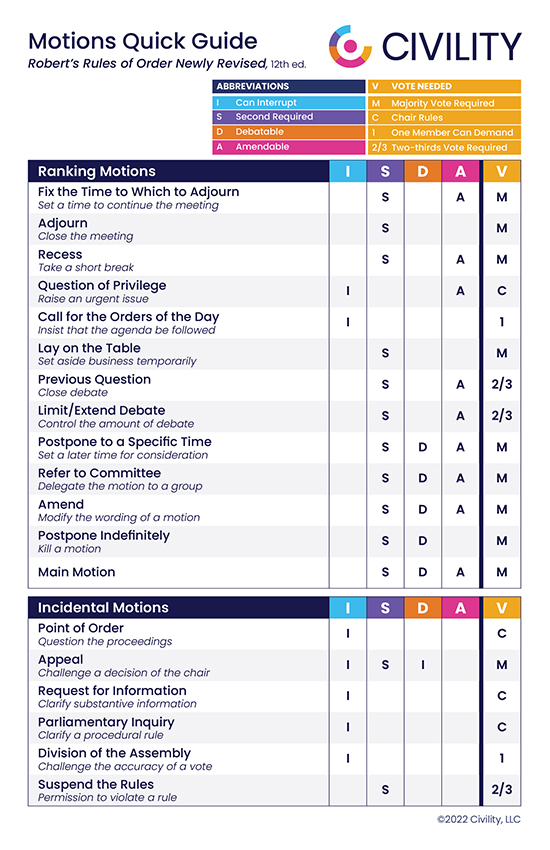Welcome to the second installment of a two-part explanation of the order of precedence—the idea within parliamentary procedure that main motions and some secondary motions have rank and must be dealt with in a certain order when there’s more than one in play.
If you’re just tuning in, take a minute to read Part 1, which provides a basic understanding of this whole thing.
Part 1 explained types of motions and a list of ranking motions in order. Here’s the list again for reference (also summarized on a downloadable Motions Quick Guide PDF):
Ranking Motions
- Fix the Time to Which to Adjourn
- Adjourn
- Recess
- Question of Privilege
- Call for the Orders of the Day
- Lay on the table
- Previous Question
- Limit or Extend Debate
- Postpone to a Specific Time
- Refer to Committee
- Amend
- Postpone Indefinitely
- Main Motion
Today’s post follows up the list with a guide on how to use it.
The Operating Principle: A higher ranking motion must be dealt with first.
The principle of the order of precedence is that the closer the item is to the main motion (at the bottom of the ranked list), the lower it is in the ranking. (Said the opposite way, the motions at the top of the list are furthest from the main motion and highest in the ranking.)
- The list works from top to bottom.
- You always have to deal with a motion that has the highest rank (is at the top of the list) first.
- Once a motion of a certain rank is proposed, no motions below it in rank can be made until that higher ranked motion is taken care of.
A Visual Aid
Have you ever seen a Russian matryoshka doll—commonly called a “nesting doll”? These beautiful wooden dolls traditionally include carved, painted figures of varying sizes, each coming apart to reveal a smaller one tucked inside. To get to the smallest doll, you have to open each outer, bigger doll.
For many groups, the nesting doll idea is a helpful illustration for remembering how to deal with motions successively without making a big mess.
Here’s an example:
- The main motion is the smallest, innermost doll—bottom of the list. It’s been presented and is up for discussion.
- Then, pretend a motion to “postpone indefinitely” is proposed.
- But perhaps another member jumps in with a motion to “refer to committee.”
- No one has proposed a motion to “amend.”
What’s next?
Using the above ranked list as a guide….
- “Stack” each presented motion “inside” the next higher motion that’s been presented—making sure you follow the order of precedence. So, the main motion “goes inside” the motion to postpone indefinitely, which goes inside the motion to refer to committee.
- And the motion to amend “doll” would be set aside—it’s not in play.
- Other motions can still be presented at this point—anything higher in rank/up the list, not lower.
- Then, once all motions presented have been “stacked” in order, deal with the highest ranked motion, following the normal six-step motion process.
The Impact of One Motion on Another
So, you’re working through motions one at a time. And once a motion has been dealt with completely, the next motion “inside” that one comes into play. But, here’s where the “doll-opening” situation can take a different turn.
- Based on the results of any particular motion, some motions “tucked inside” may become irrelevant.
- For example, if a motion to adjourn results in a vote in favor of ending the meeting, you’re done—put all the dolls away.
- But if a motion to refer to committee does not pass, then the next motion down the list (“inside” that one) should be handled next.
And yes—once you’ve dealt with all ranking motions, follow the same good ol’ motion process to finish handling the main motion.
The Takeaway
Understanding how motions work in coordination with one another is key to moving business along in an orderly and efficient manner. The order of precedence gives you legitimate strategic options when discussion is getting long or progress has stalled. Don’t stress about memorizing the ranking motions list—just keep it nearby for reference and practice various motion sequence scenarios. It will very likely prove to be a useful tool.
Where to Learn More


